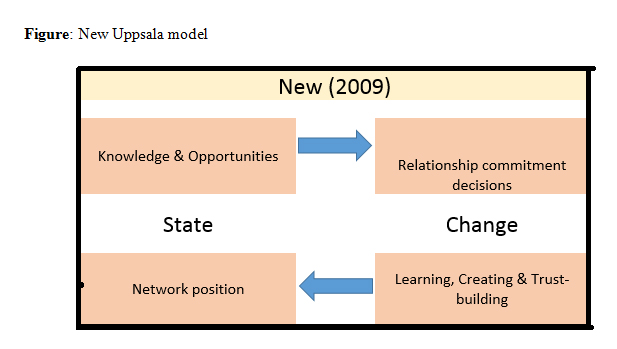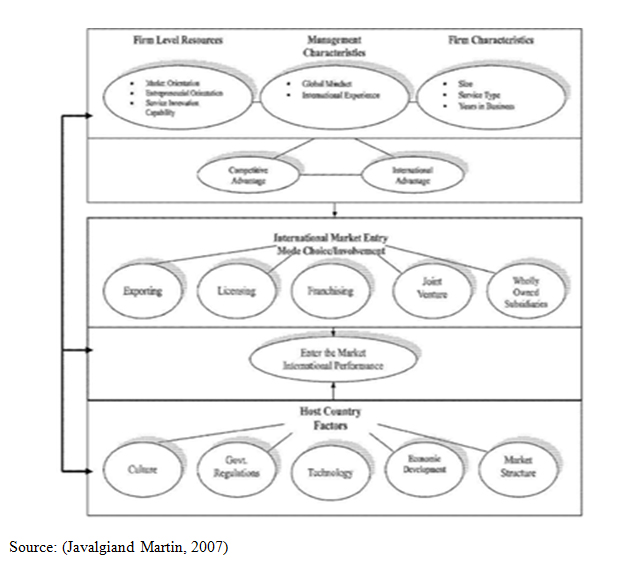Internationalization of Service Firms (International Business)
In current economic situation, services are more significantbecause companies are operating at global level. Services are the fastest growing part of international tradeinternationalisation.It is generallyobserved as a process through which companyprogresses from its home market to global markets (O'Farrell et al., 1998). Hence, internationalisation of services is attracting to management scholars for research. The fact that services are a motivating force and the fastest increasing sector in worldwide trade attracts academicians to follow the alterations occurred in the service business.Currently, technology advancement in marketplace and varying economic markets have brought new insights which have great impact on the internationalisation processes of the any organization. It is obvious that internationalisation not always can be recognized as a conventional, incremental process (Oviatt and McDougall, 1994).
A service firm is a business that makes its facilities available to others for a fee such as Wipro, Infosys, and Tech-Mahindra. Service firms can be professional service firms and financial service firms.In professional service firms infrequent, technical or uniquefunctions are performed by independent contractorsor by consultants. It offers services like Accountancy, business consultancy etc. Financial service firms offer services such as managing money. It includes banks, insurance companies, consumerfinance companies, stock brokerages etc.Name of few financial service firms are in India are Bajaj capital limited, DSP Merrill Lynch Limited.
The majordevelopment of the service sector in the internationalfinancial system has promoted a need for investigation on international services marketing (Javalgi et al., 2003). There are manytheorists who contributed their efforts on the internationalisation of manufactured goods but little journals represent the internationalisation of services (Lovelock, 1999). Whereas some investigatorsasserted that many aspects viewed in the industrialarea are also appropriate to the service sector (Boddewyn et al., 1986). Otherstheorists argued that internationalisation of services have many distinguishing characteristics (Knight, 1999) and should be considered distinctively.Companies do business in global market for several reasons. According to Root (1994), manufacturing firms and service firms go through foreign markets because home markets are inactive or foreign markets are increasing faster. Some follow their domestic customers who are going international, some firms may go abroad to increase sales or in order to lessen costs thus they strengthen their competitiveness at home as well as overseas markets. Many scholars realized that the internationalization of services is a comparativelyunidentified field. It has been proposed that there is no need for precise theories of service firm internationalisation because the existing theories of internationalisation are directly applicable to the service context, or could be adapted to the context of service firms (Boddewyn et al. 1986; Buckley et al. 1992).Otherresearchers indicated that patterns of internationalisation in the service sector vary from those in the manufacturing sector (e.g., Erramilli and Rao, 1993). Javalgi and Martin (2007) stated that theories based on manufacturing firms offer good theoretical structure for further expansion and alteration of the existing research to a multinational service context, but there is still a need to develop new theories that unite the various theoretical constructs to describe and foresee a service firm's behaviour. According to studies, service firms generally follow someinternationalisation patterns. First, a service firm can internationalisethrough customer following approach. Second, service firms can internationalise as a response to a competing service firm´s actions. Third, globally active service companies can be called market seekers (Erramilli, 1990). These three patterns can be associated with the Network approach. Erramilli (1990) and Erramilli and Rao (1993) have acknowledged that the internationalization of service companies have mostly been done through foreign direct investment and contractual arrangements. Gronroos (1999) explains three general entry modes such as client following, market-seeking and electronic marketing mode. There are five main strategies of making service accessible in selected foreign market: direct export, systems export, direct entry, indirect entry and electronic marketing. The selection of a foreign market and the choice of an appropriate foreign-entry mode are associated with the performance and survival of the firm.
The international business studies had a great impact are the behavioural or stage theories. A famous model of this field is the internationalisation process model of Johanson and Vahlne (1977), also known as the Uppsalamodel. The model represents that companies will tend to internationalise first to psychically close countries and slowly move to more psychically distant markets. The model also reveals that, as a firm decides a new foreign country, it will begin from a low resource-commitment mode and only move to higher commitment modes as it gains experiential facts in the overseas market.The Uppsala Model of internationalization processes comprises of four stages, which explains how the learning and opportunity perception affect, and is affected by the current environment of the firm. In the new model from 2009, relationships and networks are considered extensively.

Assumptions of the Uppsala Model
The Uppsala Internationalization Model wasoriginally developed based on case studies of Swedish producers (Johanson & Wiedersheim-Paul, 1975). It adopted a behavioural viewpoint (Andersen and Buvik, 2002). The model emphasizes that a firm's market knowledge would be the motivating force of its internationalisation path. Market understanding is seen as a purpose of psychic distance between home and host countries and the firm's deep experience in each given market. The model asserts that firms select new countries for development according to their psychic proximity to the host country, moving to more psychically distant countries and resource commitments in each selected country increase in incremental steps as the firm gains experience in each market.
Relevance of Services in International Trade
Services symbolize a major part of the world GDP and account for a considerable share of international trade (Axinn and Matthyssens, 2002). Furthermore, the internationalisation of services has been increasing at a rapid rate (Dunning, 1989). Historical facts suggest that while in the 1970s it represented around 25% of the world's FDI stock, in the early 2000s it accounted for 60% of the stock and two-thirds of FDI inflows (United Nations Conference on Trade and Development, 2004).
Variables affecting the Internationalisation of Services
Theorist such as Erramilli (1990)investigated dissimilarity in entry mode choice across service industries and found that hard services firmswhere production can be decoupled from consumption tend to select similar entry modes as would product firms, but soft services firms where production and consumption occur concurrently tend to use more incorporated entry modes. Furthermore, as the need for customization becomes stronger, service firms would tend to choose more incorporated entry modes. Ekeledo and Sivakumar (1998) supported Erramilli's (1990) generic argument which demonstrated that entry mode decisions varyconsiderably between hard and soft services, but that hard services showed similarities with commodities. Cloninger (2000) determined that services which were less vague, less perishable and less concurrent had a higher likelihood to internationalise, and that intangibility was a predictor of entry mode.
Erramilli (1991) also examined the effect of a service firm's international experience on the type of foreign country selected and the mode of entry selected. He found that, in support of generally accepted internationalization hypothesis, as service firms become more experienced, they tend to enlargeto more psychically distant countries. He found a curvilinear (U-shaped) relationship between experience and the degree of control of the entry mode selected. Sanchez-Peinado and Pla-Barber (2006) found that cultural distance did not extensively influence the choice of entry mode by service firms. They found, nevertheless, a negative relationship between international experience and the choice of higher-control entry modes, partially supporting Erramilli's (1991) results and contradicting Uppsala's predictions.The complexity of services pushed researchers to concentrate their investigation on the internationalisation process from the perspective of one single service industry, thus avoiding the issue of differences across industries. For example, specific studies have been done on the internationalization of business services (O'Farrell, Wood, and Zheng,), engineering consulting (Baark, 1999), financial services (Katrishen and Scordis, 1998), hospitality (Alexander & Lockwood, 1996; Dunning &Kundu, 1995), professional services (Skaates, Tikkanen, and Alajoutsijarvi, 2003), and software (Ojalaand Tyrväinen, 2007). Andersen (1993) asserted that except for the initiating mechanism, the differences between these models reveal semantic differences rather than real differences concerning the nature of the internationalisation process. Firms are expected to follow a progression from low to high commitment modes of operation and to enter new markets with successively higher psychic distance. Since last many decades, numerous studies focusing on the fact that many new firms are internationalisingquickly, in a way that is not reliable with the slow process with stages defined above (Cavusgil and Knight).
Javalgi and Martin (2007) stated that the resource-based view of the firm has emerged as a theoretical frame to scrutinize suitable competitive advantage in the areas of service marketing and management.
Framework for internationalisation of services
Mode of Entry
- Client-Following Mode: Firms follow manufacturers that they are supplying with services, into their domestic market.
- Market-Seeking Mode: In efforts to expand service firms, search internationally for new markets.
- Electronic Marketing Mode: Technological advances of today have created many new opportunities for internationalization.
There are five main Strategies for Internationalising Services
Export Strategies
- Direct Export,
- Systems Export
Entry Strategies:
- Direct Entry
- Indirect Entry
Electronic Strategies:
- Electronic Marketing
Barriers / Challenges to Internationalisation
In the initial and later stage of internationalisation, it is important to check barriers and take steps to deal with these issues (Czinkota, 1994). Although international business experience and accumulated knowledge do diminish barriers, newcomers and born global companiesmay undergo similar problems (Jaklic and Svetlicic, 2003). When a firm reveals on the likelihood to enter in a foreign country, it must consider the country's social, legal, economic and political framework (Quer et al., 2007). An important difference between successful and unsuccessful firms in the process of internationalisation is the ability to learn by seeking knowledge about international markets, potential customers, and an issue of operations management in distant and unknown environments (Craig and Douglas, 1996). Obstacles of internationalisation include lack of resources, too little knowledge about exporting, and the belief that cultural differences may make the process more difficult (Winstead and Patterson, 1998). Major challenges of service firms to move to foreign market is that most literature on internationalization and export strategies is geared towards the needs of manufacturing firms rather than service firms. Researchers have little knowledge about how service firms enter foreign markets and there has been little practice to back up theory.
To summarize, globally, company needs to implement and evaluate internationalisation strategies. Different researchers have developed dissimilar tools and theories to explain internationalisation of firms and have made diverse suggestion of dealing with this changing situation.Service industries offers links between geographically dispersed monetary activities and have vital role in the growing interdependence of markets and production activities across nations.

